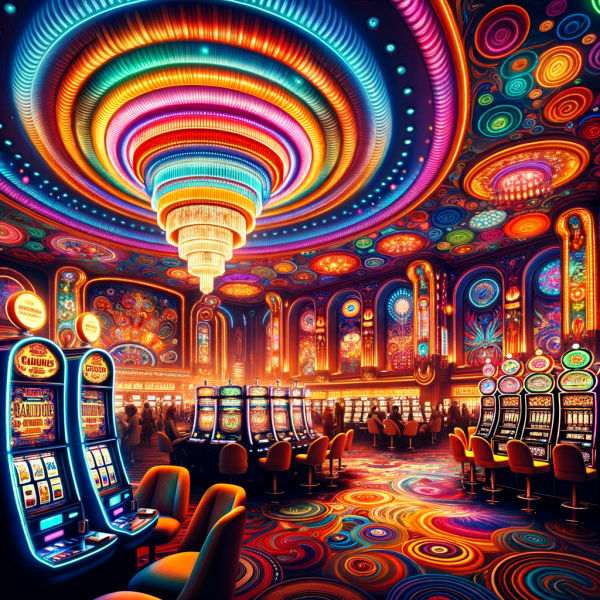The Psychological Impact of Color in Casino Design
The interplay between color and psychology is a powerful tool that casinos exploit to enhance the gaming experience. Colors have the ability to evoke specific emotions and responses, shaping how individuals perceive their environment. Casinos utilize vibrant hues to create a stimulating atmosphere that encourages players to linger longer and play more. Research shows that colors can influence decision-making, leading to impulsive choices that benefit the house. For instance, red is often associated with excitement and energy, while blue can evoke a sense of trust and reliability.
In a casino setting, the strategic use of colors can manipulate mood and behavior. Bright colors like yellow and orange are often used in areas designed for social interaction, as they promote feelings of happiness and warmth. Conversely, darker shades may signify luxury and sophistication, often seen in high-stakes areas to attract affluent clientele. The choice of colors is not arbitrary; it is a carefully crafted aspect of casino design intended to optimize player engagement and spending.
Moreover, the cultural significance of colors cannot be overlooked. Different cultures interpret colors uniquely; for example, while red symbolizes good fortune in some Asian cultures, it may evoke aggression in others. Casinos are keenly aware of their target demographic and often tailor their color schemes accordingly, ensuring that the environment resonates positively with players from various backgrounds. This cultural sensitivity enhances the overall customer experience, making players feel more at home and less like outsiders.
Ultimately, the psychological ramifications of color extend beyond mere aesthetics. By inducing specific moods and reactions, casinos can effectively manipulate players’ experiences, leading to increased time spent on the gaming floor. The mastery of color psychology in casino design is a testament to the industry’s understanding of its clientele and the lengths to which it will go to maximize profitability.
Illuminating Choices: The Role of Lighting in Gambling
Lighting plays a crucial role in the casino experience, often working in tandem with color to create an immersive environment. Bright, strategic lighting draws attention to key gaming areas, such as slot machines and table games, enhancing their visibility and attractiveness. Casinos frequently employ a combination of ambient, task, and accent lighting to highlight different zones within the establishment, ensuring that players feel both engaged and comfortable.
Task lighting is particularly important in areas where players need to see the details, such as at card tables or electronic gaming machines. This focused lighting allows for optimal visibility, reducing strain as players engage in their games. On the other hand, ambient lighting creates a general atmosphere, often designed to be warm and welcoming, encouraging guests to explore the venue. This combination of lighting types not only enhances the visual appeal but also facilitates a seamless gaming experience.
Moreover, the effects of lighting extend to mood regulation. Dimmer lighting can create a sense of intimacy and exclusivity, drawing players into a world where time seems to stand still. In contrast, brighter lights can elevate energy levels, making the gaming experience feel more vibrant. Casinos often adjust lighting levels based on the time of day or player behavior, ensuring that the atmosphere remains dynamic and appealing throughout operational hours.
Importantly, the psychological effects of lighting extend to the subconscious level. Studies indicate that well-lit environments can increase alertness and foster a sense of excitement, while dimmed lighting can lead to feelings of relaxation and contentment. By mastering the art of illumination, casinos can enhance the gambling experience, encouraging players to make that extra bet or stay for just one more round.
How Warm Colors Create a Welcoming Atmosphere
Warm colors, such as reds, oranges, and yellows, are frequently employed by casinos to create an inviting atmosphere. These hues are associated with warmth, energy, and enthusiasm—qualities that resonate with the thrill of gambling. When players enter a casino painted in warm colors, they are more likely to feel welcomed and socially engaged. This is crucial in establishing a positive first impression that can influence their overall experience.
Moreover, warm colors can stimulate appetite and promote social interaction. Restaurants within casinos often use these hues to attract diners, encouraging patrons to linger and enjoy the culinary offerings before or after their gambling session. The inviting ambiance created by warm colors can also increase players’ emotional investment in their gaming experience, leading to more prolonged engagement.
Furthermore, the psychological effects of warm colors can encourage risk-taking behavior. The vibrant energy associated with red and orange can evoke feelings of excitement and urgency, prompting players to make quick decisions, such as placing larger bets. This element of impulsivity can significantly benefit casinos, as players may overlook caution in favor of thrill, resulting in increased revenue.
In summary, the strategic use of warm colors in casino design fosters a welcoming and engaging environment. By tapping into the psychological associations linked to these hues, casinos can create spaces that not only attract players but also encourage them to immerse themselves in the experience, ultimately enhancing their chances of increased spending.
The Use of Cool Colors to Encourage Calmness and Focus
While warm colors entice and energize, cool colors like blue, green, and purple serve a different purpose within casino design. These shades are often employed to instill calmness, promoting focus and clarity among players. By utilizing cool colors in less stimulating areas, casinos create spaces where players can relax and concentrate on their choices, especially in high-stakes gaming zones where decision-making is paramount.
Cool colors are particularly effective in reducing anxiety, which is crucial in a high-pressure environment like a casino. A calm atmosphere allows players to make more rational decisions rather than succumbing to impulsive behaviors driven by excitement. This environment is ideal for table games such as blackjack and poker, where strategy and composure can lead to better outcomes.
Moreover, the strategic implementation of cool colors can enhance the overall visual appeal of the casino, creating a balanced environment that does not overwhelm players. By integrating these hues with warm colors, casinos can design spaces that cater to the diverse emotional needs of their clientele. This harmony between cool and warm colors can facilitate a more inclusive atmosphere, accommodating both high-energy and low-key experiences.
In essence, the use of cool colors in casino design serves as a counterbalance to the excitement generated by warm hues. By fostering a sense of calm and focus, casinos can enhance players’ decision-making abilities, thus encouraging a more thoughtful and potentially profitable gaming experience.
The Science Behind Lights and Their Effect on Mood
The interplay between light and mood is a well-researched area within psychology and environmental design. Different lighting conditions can elicit various emotional responses, influencing how individuals feel and behave in a given space. Casinos leverage this scientific understanding to create environments that maximize player comfort and engagement.
Bright lighting has been shown to increase alertness and energy levels, making players feel more active and engaged. Conversely, dim lighting can create a soothing atmosphere that helps individuals relax. This duality of effect allows casinos to manipulate lighting conditions strategically throughout the gaming floor. For instance, high-energy areas, such as dance floors or slots, are often brightly lit, while quieter lounges or high-stakes rooms may employ softer, ambient lighting to create a more tranquil experience.
Additionally, the color temperature of lights plays a crucial role in influencing mood. Warmer light temperatures, such as those found in incandescent bulbs, can create a cozy, inviting environment. In contrast, cooler light temperatures, akin to daylight, can foster alertness and clarity of thought. Casinos often utilize a mix of these lighting temperatures to cater to different areas and activities within the establishment, ensuring that the mood aligns with the guests’ needs.
Ultimately, the science behind light and mood is a fundamental aspect of casino design. By understanding how different lighting conditions affect emotional responses, casinos can create environments that enhance player satisfaction, encouraging longer stays and increased spending.
Strategic Color and Light Combinations to Boost Spending
The combination of color and light is a powerful strategy that casinos utilize to boost player spending. By carefully mixing hues and adjusting lighting levels, they create environments that heighten emotional responses and stimulate excessive gambling behavior. Certain color-light pairings, for instance, can enhance the allure of gaming machines and tables, making them seem more attractive and exciting.
Casinos often employ a “red and gold” color scheme in high-stakes areas, where the warmth of red combined with the opulence of gold creates an atmosphere that is both energizing and luxurious. This combination not only attracts players but also enhances their perception of value, making them more willing to place higher bets. When paired with strategically placed accent lighting, these colors can draw attention to specific games or promotions, further encouraging spending.
In contrast, softer blue lighting paired with cooler colors can create a calming effect in lounge areas, encouraging players to take breaks and socialize, which indirectly boosts their gambling time. This balance between relaxation and excitement is key in encouraging guests to remain within the casino longer, increasing the likelihood of additional gaming sessions.
The effectiveness of these color-light combinations is backed by psychological principles that link visual stimuli to behavioral responses. Casinos meticulously analyze player behavior to determine which combinations yield the highest levels of engagement and spending, continually refining their strategies to optimize profitability.
| Color | Psychological Impact | Lighting Type | Ideal Gaming Area |
|---|---|---|---|
| Red | Excitement, urgency | Bright | Slots, high-stakes areas |
| Blue | Calmness, focus | Soft | Poker, lounges |
| Orange | Warmth, sociability | Medium | Social areas |
| Green | Balance, tranquility | Natural | Relaxation zones |
| Yellow | Happiness, energy | Bright | Entryways, restaurants |
Q&A Section
Q: How do casinos choose their color schemes?
A: Casinos evaluate the emotional and cultural associations of colors to create appealing environments that resonate with their target demographics.
Q: What lighting types are most commonly used in casinos?
A: Casinos typically use a combination of ambient, task, and accent lighting to create a balanced atmosphere that enhances player engagement.
Q: Do warm colors really encourage spending?
A: Yes, warm colors can evoke feelings of excitement and energy, prompting players to make quicker decisions and take risks, leading to increased spending.
Q: How do casinos adjust lighting throughout the day?
A: Many casinos alter lighting levels based on time of day and player behavior, ensuring the atmosphere remains dynamic and inviting.
Q: Is there a science behind the color and light combinations used in casinos?
A: Absolutely! Research indicates that specific combinations of colors and lighting can elicit particular emotional responses, which casinos leverage to enhance player satisfaction and encourage spending.




